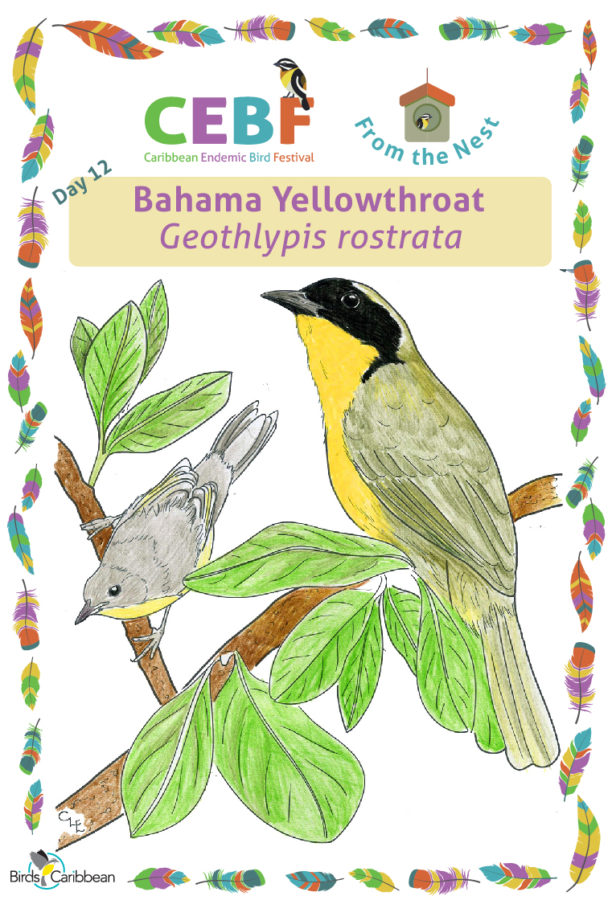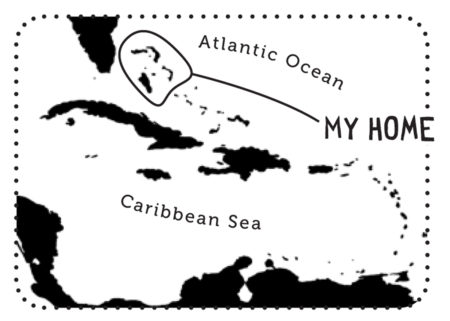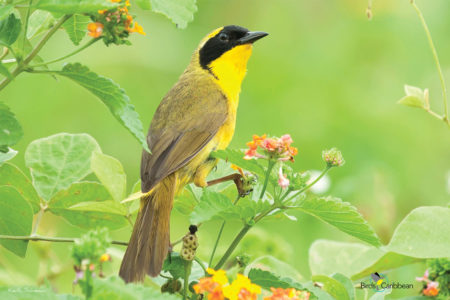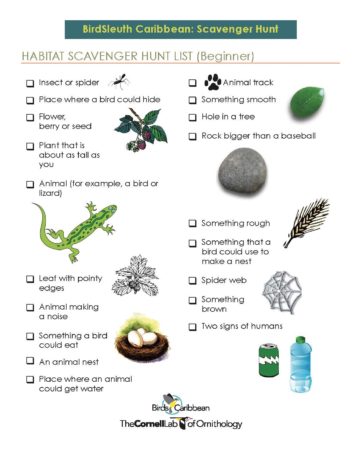Celebrate the Caribbean Endemic Bird Festival (CEBF) with us in our virtual “From the Nest” edition! Have fun learning about a new endemic bird every day. We have colouring pages, puzzles, activities, and more. Download for free and enjoy nature with your family at home.

Endemic Bird of the Day: Bahama Yellowthroat
 The Bahama Yellowthroat is one of five endemic bird species found in The Bahamas. It was first discovered by Dr. Henry Bryant during an expedition to The Bahamas in 1865-1866. It is a relatively large warbler species in the Family Parulidae, about 5.5in (14cm) long. There are three subspecies and they can be found on the islands of Grand Bahama, Abaco, Andros, Eleuthera and Cat Island. There was a population on New Providence, but it is believed to be extirpated.
The Bahama Yellowthroat is one of five endemic bird species found in The Bahamas. It was first discovered by Dr. Henry Bryant during an expedition to The Bahamas in 1865-1866. It is a relatively large warbler species in the Family Parulidae, about 5.5in (14cm) long. There are three subspecies and they can be found on the islands of Grand Bahama, Abaco, Andros, Eleuthera and Cat Island. There was a population on New Providence, but it is believed to be extirpated.
The Bahama Yellowthroat male has a striking black face mask that makes it look like a bandit. Its back, nape, and tail are olive green, contrasting with a bright yellow throat and belly. The bright yellow coloration may serve as an “honest” signal to potential mates, indicating a healthy mate. The female is duller colored with no face mask. Its song is a loud whichity-whichity-whichity similar to a Common Yellowthroat, but louder and richer. It also has a sharp chip note.They feed on arthropods and nest in low, scrubby vegetation.
The Bahama Yellowthroat is an attractive endemic Bahamian species but it is more often heard than seen due to its skulking behaviour. It can be distinguished from Common Yellowthroats, which are common and widespread winter visitors, by its greater size, longer and heavier bill, and more uniformly yellow underparts. They also live in different habitats—the Bahama Yellowthroat prefers wooded areas while the Common Yellowthroat lives in wetlands. Learn more about this species, including its range, photos, and calls here.
Colour in the Bahama Yellowthroat!
Download the page from Endemic Birds of the West Indies Colouring Book. Use the drawing above or photo below as your guide, or you can look up pictures of the bird online or in a bird field guide if you have one. Share your coloured-in page with us by posting it online and tagging us @BirdsCaribbean #CEBFfromthenest
Listen to the call of the Bahama Yellowthroat
The Bahama Yellowthroat’s song is remarkably similar to the Common Yellowthroat, calling loudly and clearly witchity-whitchity-witchity.
Puzzle of the Day
Click on the image below to do the puzzle. You can make the puzzle as easy or as hard as you like – for example, 6, 8, or 12 pieces for young children, all the way up to 1,024 pieces for those that are up for a challenge!

Activity of the Day
 FOR KIDS & ADULTS: Hone your observation skills and go on a Nature Scavenger Hunt! Print the cards on sturdy paper and use a clipboard or piece of cardboard as a writing surface outside. Younger children can do side 1 of the card, older children side 2. English, Spanish and French versions are available for free download here!
FOR KIDS & ADULTS: Hone your observation skills and go on a Nature Scavenger Hunt! Print the cards on sturdy paper and use a clipboard or piece of cardboard as a writing surface outside. Younger children can do side 1 of the card, older children side 2. English, Spanish and French versions are available for free download here!
All living things have a habitat—a place that provides the food, water, cover, and space that they need to survive. Cover includes nesting areas, places to sleep or rest, places to hide or escape, and shelter. Space means a big enough area to hunt and feed, find nesting areas, and for some bird species, to migrate safely. If a place does not provide the right food, water, space, and cover in a suitable amount, a plant or animal cannot live there.
Talk about this with your kids and then go outside to investigate your habitat using the Habitat Scavenger Hunt cards. Instead of collecting the items on the list, this is an observation scavenger hunt. Have your child or children check off the items (with a pencil or pen), as they are located. When everyone has had a chance to look for the items listed, come back together to chat about where they were located. Were any difficult or impossible to find? Why do you think that was? For example, it might be impossible to find animal tracks when it is very dry, or certain animals depending on the time of year.
